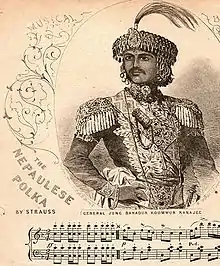Rana (title)
Rana (IAST: Rāṇā, Sanskrit: राणा) is a historical title denoting an absolute Hindu monarch[1] in the Indian subcontinent. Today, it is used as a hereditary name in the Indian subcontinent. "Rana" was formerly used as a title of martial sovereignty by Rajput kings in India.[2] Rani is the title for the wife of a rana or a female monarch. It also applies to the wife of a raja. Compound titles include rana sahib, ranaji, rana bahadur, and maharana.

Usage in the Indian subcontinent

.jpg.webp)
"Rana" was formerly used as a title of martial sovereignty by Rajput kings in India.[2] Sisodia rulers of Mewar used the title of Mahārāṇā (महाराणा) extensively in their royal charters.[3] Today, members of some Rajput clans in Indian subcontinent use it as a hereditary title. In Pakistan, mostly Muslims—but also some Hindus in Sindh (present-day Pakistan)—use it as a hereditary title.[4] Amarkot, a state in Sindh, has a Hindu Thakur Sodha Rajput ruler who uses the title.[5]
In the 16th century, Rana Prasad, the monarch of Amarkot, gave refuge to the Mughal prince Humayun and his wife, Hamida Banu Begum, who had fled from military defeat at the hands of Sher Shah Suri. Their son Akbar was born in the fort of the Rana of Amarkot.[6]

The head of the Kunwar nobles of Nepal, Jung Bahadur Kunwar, took the title of Rana(ji) and Shree Teen Maharaja after consolidation of his post of Prime Minister of Nepal. This dynasty controlled administration of the Kingdom of Nepal from 1846 until 1951, reducing the Shah monarch to a figurehead and making Prime Minister and other government positions hereditary.[7][8]
As a title
- The Kolis of India used the title of Rana and ruled over Princely State of Shevdivadar[9] and Sinhagad fort was ruled by Koli Rana Nag Nayak who challenged the Delhi sultanate's Sultan Muhammad bin Tughluq.[10][11]
| Part of a series on |
| Imperial, royal, noble, gentry and chivalric ranks in West, Central, South Asia and North Africa |
|---|
.svg.png.webp) |
|
Rana rule in Nepal
The Rana rule in Nepal from the mid-1800s to the mid-1900s saw a whole century of oppression of Nepalese who became Buddhist monks. The first victims were Nepalese Mahayana (Tibetans) who converted to Buddhism, then Theravada Buddhism in the "History of Theravada Buddhism in Nepal" to stop their discriminatory practices.[15]
Dress
Dress varies from region to region. Historically, traditional Indian clothing was worn.
References
- Sandeep Sinha (2021). I Wasn't Born For This. BFC Publications. p. 94.
- Bhattarai, Krishna (2009). Nepal. Infobase Publishing. p. 42. ISBN 9781438105239.
- Ulian, Eva (23 March 2010). Rajput. WestBow Press. ISBN 978-1-4497-0061-4.
- "Rajput appeal from Amarkot". The News International, Pakistan. 24 July 2013. Retrieved 10 September 2015.
- P B Chandra (10 August 2009). "Rana kin in Pakistan for mourning". The Times of India. Retrieved 5 September 2021.
- "Umerkot's former Rajput ruler is dead". The Hindu. Retrieved 5 September 2021.
- Dietrich, Angela (1996). "Buddhist Monks and Rana Rulers: A History of Persecution". Buddhist Himalaya: A Journal of Nagarjuna Institute of Exact Methods. Retrieved 5 September 2021.
- Lal, C. K. (16 February 2001). "The Rana resonance". Nepali Times. Retrieved 5 September 2021.
- Lethbridge, Roper (2005). The Golden Book of India: A Genealogical and Biographical Dictionary of the Ruling Princes, Chiefs, Nobles, and Other Personages, Titled Or Decorated of the Indian Empire. New Delhi, India, Asia: Aakar Books. pp. 501: Shevdivadar, The Rána is a Koli (aboriginal) Chief, ruling over a territory of 1 square mile, with a population of 246, chiefly Hindus. Residence - Shevdivadar, Kathiawar, Bombay. ISBN 978-81-87879-54-1.
- Kale, Rohit Pralhadrao (24 May 2018). Rajwata: Aavishkar Gad Killayacha. New Delhi, India, Asia: FSP Media Publications. pp. Sinhagad was captured from the Koli tribal chieftain, Nag Naik, by Muhammad bin Tughlaq in 1328 AD. Shahaji Bhosale, as the commander of Ibrahim Adil Shah I, was entrusted with the control of the Pune region. His son Shivaji, however.
- Mehta, Jaswant Lal (1986). Advanced Study in the History of Medieval India: 1000-1526 A.D. New Delhi, India, Asia: Sterling Publishers. pp. 197: Sultan was told that Nag Nayak, Rana of Kondhana (Sinhgad, near Poona ) did not pay tribute of Delhi . ' On his orders, the fortress was besieged by a contingent of the royal army, it was defended gallantly by. ISBN 978-81-207-0573-9.
- theIndia's Communities. Oxford University Press. 1998. ISBN 978-0-19-563354-2.
- Bhattarai, Krishna P. (2009). Nepal. Infobase Publishing. ISBN 978-1-4381-0523-9.
- توصیف الحسن میواتی الہندی (23 August 2020). تاریخِ میو اور داستانِ میوات.
- "Buddhist Monks and Rana Rulers". ccbs.ntu.edu.tw. Retrieved 3 July 2020.